Waffles SS
Fighter
   
Posts: 998
Registered: 7-12-2009
Member Is Offline
|
|
Fractional Distillation
I decide to create this topic for sharing experiences to build up fractional distillation system.I usually use glass pearl for filling Fractional
column but i think this is possible to use reflux condenser with controllable temperature instead of it(Maybe Lab chiller is useful for controlling
condenser temperature).
I usually use below system and I'm always trying to upgrade it !
Hotplate Stirrer
Flat boiling flask(i cover it with Aluminium foil)
30cm Fractional column filled with 6mm glass pearl
Connecting head Distillation(with thermometer and thermometer connector)
Expansion adapter
Silicone hose
Adapter hose connector
Reflux condenser(i am lazy for changing it to coil condenser)
Funnel
Receiver(usually Flat boiling flask or measuring cylinder)
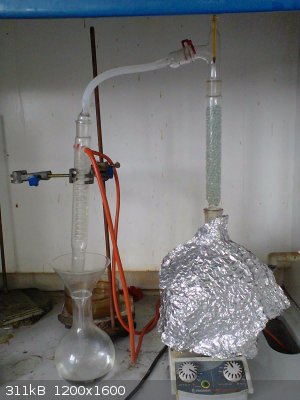
[Edited on 30-3-2017 by Waffles SS]
|
|
|
Magpie
lab constructor
    
Posts: 5939
Registered: 1-11-2003
Location: USA
Member Is Offline
Mood: Chemistry: the subtle science.
|
|
I, too, am always looking for ways to improve my fractional distillation capability. I have 20cm and 60cm columns, but both are 12.7mm ID. Most of
my feed batches are small (<100 mL) so to reduce holdup I'm using these small diameter columns. I use broken glass or ss scrubber pad as packing.
I prefer the ss pad but sometimes go to the glass packing due to corrosion of the ss.
Flooding is often a major problem. This is exacerbated by the small diameter column and/or too tight of ss pad packing, or if the random packed glass
doesn't stack well.
I've thought I could do much better with a column that was of larger diameter, say 25mm.
Also, I don't think my packing is optimum. Glass or ptfe helices might be better - but are expensive. Raschig rings in glass or ptfe might be better
too.
I've wanted to to try a "structured" packing but can't justify the cost. Here's one vendor who offers this for lab sized columns:
https://www.sulzer.com/en/Products-and-Services/Separation-T...
The single most important condition for a successful synthesis is good mixing - Nicodem
|
|
|
Waffles SS
Fighter
   
Posts: 998
Registered: 7-12-2009
Member Is Offline
|
|
I have access to lot of PVC and PP structured packing that use in cooling tower.I dont know that is effective for fractional column or not
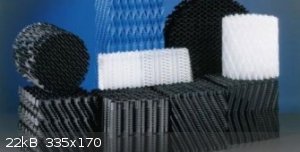
[Edited on 30-3-2017 by Waffles SS]
|
|
|
markx
National Hazard
   
Posts: 645
Registered: 7-8-2003
Location: Northern kingdom
Member Is Offline
Mood: Very Jolly
|
|
I trust the most effective upgrade for the system pictured at the top of the topic would be to convert it to a true fractional still with adjustable
reflux ratio. Currently it relies on the uncontrolled reflux that occurs within the column due to heat loss through the outer surfaces. It does sort
of work, but lacks a lot of the fuctionality of a controlled reflux system. To achieve that, one would have to move the condenser to the very top of
the column and devise or aquire a reflux dividing section below that.
E.g. something like this (the top end of a full reflux system towering about 2,5m in column height):
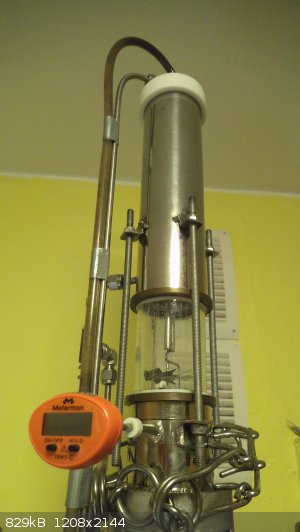 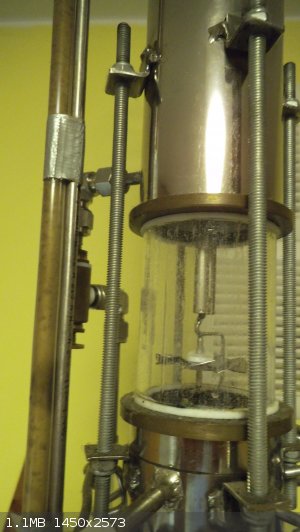
It is a metal construct, but the principle remians the same....all of the vapour phase is condensed in the cooler and fed through the reflux divider
where a predetermined partial feed is extracted and the rest flows back to column. This allows to equilibriate the column under full reflux and to
realise the most of the fractination ability of the system. After hitting the wall on separation ability with such a configuration one can start to
look deeper into the magic of column packing and all of the intricate "structured packing" designs.
For example something like this:
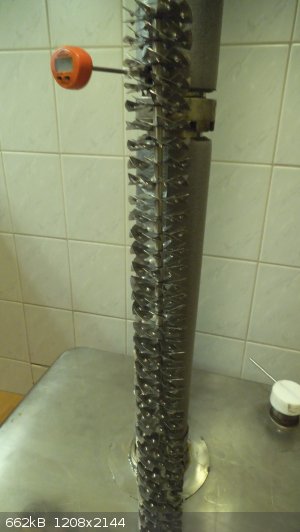 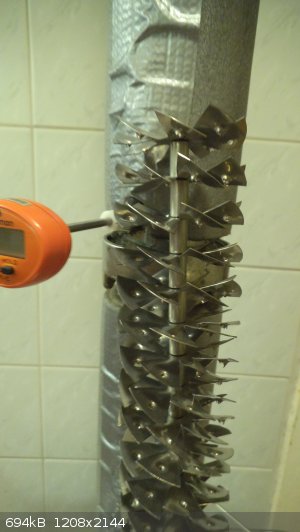 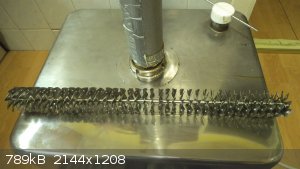
Also the packing should provide ample surface area, but not take up too much of the effective volume of the column or flooding will be a prevalent
problem. Hence the glass beads are not a very optimal solution, but rather pieces of glass tube or a woven meshlike filler (scruuber pads) would give
better performance.
Exact science is a figment of imagination.......
|
|
|
Waffles SS
Fighter
   
Posts: 998
Registered: 7-12-2009
Member Is Offline
|
|
Thanks markx,
That is great.This system should be semi pilot scale and i really didnt understand it mechanism and structure,Possible by glassware at lab scale?
I am agree that my fractional column is not effective.Longer column filled with steel sponge instead of glass beads should be better.I want to make
steel sponge by rolling steel net like below image and place it inside empty column.
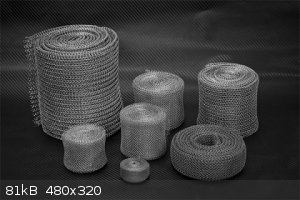
[Edited on 7-4-2017 by Waffles SS]
|
|
|
yobbo II
National Hazard
   
Posts: 709
Registered: 28-3-2016
Member Is Offline
Mood: No Mood
|
|
You can obtain stainless steel 'sponge' for washing up.
https://www.amazon.com/Royal-Stainless-Steel-Sponge/dp/B0007...
|
|
|
Waffles SS
Fighter
   
Posts: 998
Registered: 7-12-2009
Member Is Offline
|
|
Thanks,Already i have it but i think rolling steel net is more effective.
[Edited on 7-4-2017 by Waffles SS]
|
|
|
Sulaiman
International Hazard
    
Posts: 3558
Registered: 8-2-2015
Location: 3rd rock from the sun
Member Is Offline
|
|
I doubt that rolled-up steel mesh will make a good column packing material as it will conduct too much heat vertically,
and condensate would stream down back to the pot (=channelling)
I can verify that glass balls are not an efficient packing,
but chemically resistant and VERY easy to clean/re-use, a good compromise.
Steel wool is a lot cheaper than glass balls, e.g. http://www.ebay.co.uk/itm/1m-by-4-High-Grade-Stainless-Steel...
I've not tried the stainless steel pot scrubbers yet, but they look great because;
thay are 316 s/s ... good chem. compatibility
the tube-like spirals allow good gas flow and intimate flow of gas over a large area of liquid membranes.
Unless you want to build a still as a semi-permanent fixture,
fine fractionation is difficult to achieve (for me, so far)
Getting good separation requires lots of theoretical plates, reflux, and monk-like patience and dilligence.
e.g. I found the distillation of EtOH to be more efficient by multiple simple distillations and selective cutting of fractions for subsequent simple
distillations than a simple reflux column.
(25mm id, 250mm height of 3mm dia. glass balls, no insulation or external reflux)
I think that I have a little EtOH almost 95% w/w, but not azeotropic yet.
EDIT:
Waffles SS, If you measure the temperature at both top and bottom of your column,
you can get a good estimate of the effective number of theoretical plates,
... more dissapointing than you may expect 
.....................................................................
more on vertical heat transfer and general sensitivity;
my best effort so far had two vertically stacked colums as described above,
IF I had it working properly, (I didn't ... don't ask 
the difference in temperature between the top and bottom of the upper column should only be c1oC
but near the bottom of the lower column the temperature difference is very large,
(vertical heat transfer would spread out plates ... increasing the HETP).
Have a look at data for whatever it is that you wish to fractionate,
Look at the temperature difference per theoretical plate 
Then imagine how stable the environment and your still need to be 
I'm beginning to see the attraction of Vigreaux columns ...
P.P.S. You can calculate your boil-up rate (e.g. g/sec.)
convert to gas volume/second, calculate area of flask neck,
be amazed by the gas velocity 
Or, like me, observe it each time the column floods/imitates a volcanic vent 
[Edited on 7-4-2017 by Sulaiman]
CAUTION : Hobby Chemist, not Professional or even Amateur
|
|
|
Waffles SS
Fighter
   
Posts: 998
Registered: 7-12-2009
Member Is Offline
|
|
I upgraded my system.I got better result and better separation but it seems i can improve it more by upgrading fraction column.
I used 30Cm 45mm Diameter column filled with 6mm glass beads.Temperature of solution is 140 C and 130 at top of my column,there is 10 C difference.
I upgraded my system to:
Stirring heating mantle
30Cm 45mm Diameter column
40cm reflux condensser
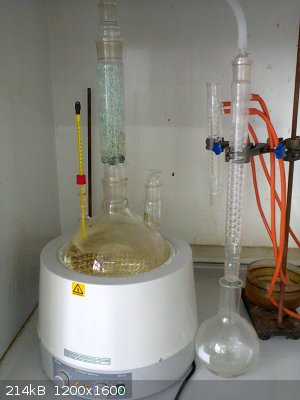 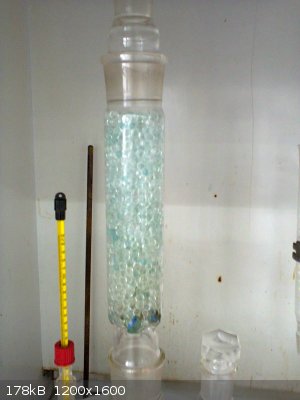 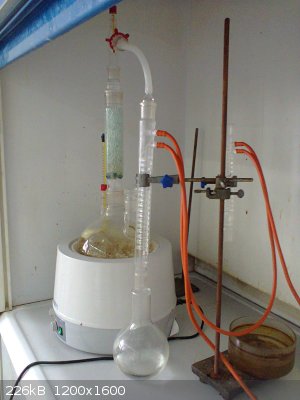
|
|
|
Texium
|
Thread Moved
27-11-2023 at 11:16 |